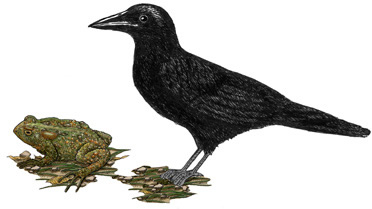

In the spring of 2005, toads in Germany and Denmark started to explode. For days it baffled scientists as more than 1,000 toad bodies appeared dead and popped. It was alarming to local residents, as the exploding seemed to be happening at night, each with a loud pop. There were no chemicals or viruses found in the waters and it only seemed to affect toads, not frogs or fish. A veterinarian from Berlin discovered that all the dead toads seemed to have similar cuts across their middles.
Then scientists discovered the culprit -- crows. Some crows discovered that they liked the taste of toad livers. Crows learned the hunting technique from other crows and soon the toads were under siege. The toads, trying to frighten off the aggressive predators puffed themselves up. The result was a body popping death epidemic.
(Popp, Trey. "Pop Went The Toads." Discover January 2006: P. 25)
Off site new resource LINK.
Essential Questions
1. How did the adaptive behavior of the crows affect the adaptive behavior of the toads?
Disciplinary Core Ideas
LS4.C: Adaptation: LINK
• Adaptation by natural selection acting over generations is one important process by which species change over time in response to changes in environmental conditions. Traits that support successful survival and reproduction in the new environment become more common; those that do not become less common. Thus, the distribution of traits in a population changes. (MS-LS4-6)
Science and Engineering Practices
Analyzing and Interpreting Data: Analyze and interpret data to determine similarities and differences in findings.
Constructing Explanations and Designing Solutions: Apply scientific ideas to construct an explanation for real-world phenomena, examples, or events.
Obtaining, Evaluating, and Communicating Information: Gather, read, and synthesize information from multiple appropriate sources and assess the credibility, accuracy, and possible bias of each publication and methods used, and describe how they are supported or not supported by evidence.
Crosscutting Concepts
Patterns: Patterns can be used to identify cause and effect relationships
Cause and Effect: Phenomena may have more than one cause, and some cause and effect relationships in systems can only be described using probability.
Connections to Nature of Science
Scientific Knowledge is Based on Empirical Evidence
• Science knowledge is based upon logical and conceptual connections between evidence and explanations. (MS-LS4-1)
Other questions that were generated in researching this Scientific Phenomena?
______________________________________________________________________________
Using Discoveries and Inventions as Scientific Phenomena to Integrate with NGSS:
______________________________________________________________________________
Scientific Phenomena can be used as a tool to anchor a science unit involving a series of lessons to engage in deeper science learning – or what is being called “Three Dimensional Learning”.
1) Describe the phenomena in a way that your students can understand and which sparks their imagination.
2) Create Essential Questions for them to answer to explain the phenomena.
3) Identify the NGSS Disciplinary Core Ideas which you are targeting.
4) Provide clear directions for a process they should use to try to answer the questions using the NGSS Science and Engineering Practices to frame as your guideline.
5) Name the Crosscutting Concepts that students should be aware of throughout the lesson.
6) Discuss the Connections to Nature of Science.
7) Make note of other questions generated in the process of exploring this Scientific Phenomena.
• Discuss them as a class.
